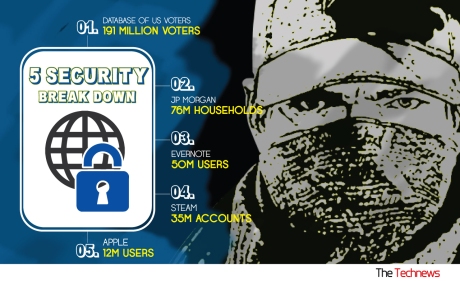In the world of Cyber Crimes, the Security Break Down of any organization’s Core value is the nightmare for any country and for the users.
The US Federal Reserve Bank in New York swapped $81m from Bangladesh’s Bank Account on February 4th 2016 into the records of four men in the Philippines, in the wake of getting what gave off a hollow of being real exchange orders. The exchange of another $20m to a Sri Lankan bank was halted after a directing bank got to be suspicious of a spelling botch and looked for illumination from the Bangladesh Bank, authorities said. Still the security specialists are waiting for the direct link through the vouchers which were sent by the hackers to the US Federal Reserve Bank. In last the 10 years many of the organizations got bailed out with this type of hacking, nevertheless the latest one claims to be the “US Voter Database Hack with 191M users” for the Recent Security Break Down!
US VOTER DATABASE HACK – 191M USERS! – YEAR 2015
By gathering the information from a well-known PC security analyst who revealed a database of records on 191 million voters that is uncovered on the open Internet because of a mistakenly designed database, he said on Monday. The database incorporates names, addresses, conception dates, party affiliations, telephone numbers and messages of voters in every one of the 50 U.S. states and Washington, analyst Chris Vickery said in a telephone meeting.
“THE ALARMING PART IS THAT THE INFORMATION IS SO CALLED CONCENTRATED,” – Vickery
Typically, the voter information is normally viewed as open data, it would be tedious and costly to assemble a database of all American voters. A trove of all U.S. voter information could be important to hoodlums searching for arrangements of substantial quantities of focuses for an assortment of misrepresentation plans.
JP MORGAN CHASE – 76M HOUSEHOLDS – YEAR 2014
On JPMorgan Chase traded off the records of 76 million family units and seven million organizations, a count that diminutive people past evaluations by the bank and puts the interruption among the biggest ever. Though the severity of the intrusion began in June but wasn’t discovered until July 2014.
“We’ve migrated so much of our economy to computer networks because they are faster and more efficient, but there are side effects,” said Dan Kaminsky, a researcher who works as chief scientist at White Ops, a security company.
EVERNOTE HACKED – 50M USERS – YEAR 2013
Every single day is the toughest day for the online security applications. It’s about the online note-taking administration Evernote which has endured a security break, prompting the California-based organization issuing secret word reset guidelines for every one of the 50 million of its clients.
“EVEN THOUGH THIS INFORMATION WAS ACCESSED, THE PASSWORDS STORED BY EVERNOTE ARE PROTECTED BY ONE-WAY ENCRYPTION.”
The administration declared in a Blog Spot throughout the weekend that its Operations and Security group had spotted suspicious movement on its system that resembled “a planned endeavor to get to secure ranges of the Evernote administration.
THE STEAM HACKED – 35M USERS – YEAR 2011
One of the secured forces from Steam, Valve revealed an interruption into a client database while examining a security break of its discourse gatherings. The aggressors utilized login subtle elements from the gathering hack to get to a database that held ID and charge card information.
The initial investigation showed that the attackers gained access to a Steam database that held “user names, hashed and salted passwords, game purchases, email addresses, billing addresses and encrypted credit card information”.
APPLE UDID LEAK – 12M USERS – YEAR 2012
On March 2012, BlueToad said in an announcement that it was the “casualty of a criminal digital assault, which brought about the robbery of Apple UDIDs from our frameworks.” A UDID is a one of a kind gadget identifier, which Apple has emphatically urged engineers to move far from for protection reasons.
“VICTIM OF A CRIMINAL CYBER ATTACK WHICH RESULTED IN THE THEFT OF APPLE UDID’s FROM OUR SYSTEM.” – BlueToad
Source: 5 Shocking Security Break Downs in the History of the Cyber World! | TheTechNews












